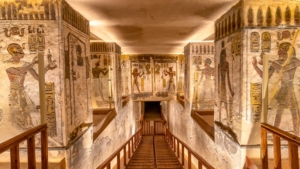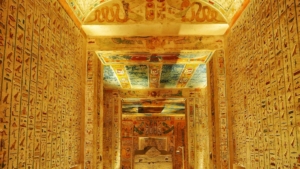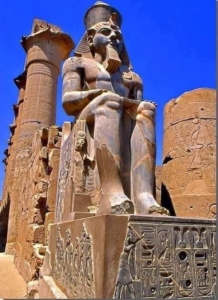The Valley of the Kings is a remarkable archaeological site in Luxor, Egypt, situated on the west bank of the Nile River. This location is renowned for its series of pharaonic tombs, constructed to house the remains and treasures of rulers from Egypt’s New Kingdom.
Here are some fascinating and unique secrets about the Valley of the Kings:
1-
Serving as a royal burial
ground for nearly 500 years—from the 16th to the 11th century BC—the Valley of the Kings contains over 60 tombs. Many archaeologists believe numerous undiscovered tombs still exist in the area.
2-
Pharaohs believed in an afterlife
, and their tombs were designed to secure their journey into the next world. These tombs were filled with spells, elaborate decorations, and treasures to assist them in the afterlife.

3-The site was selected for its natural pyramid-shaped peak, el-Qurn, which was thought to symbolize the primordial mound from which Egyptians believed creation emerged.
4-Unlike earlier pyramids, New Kingdom tombs were hidden to protect them from grave robbers. Their entrances were often concealed and camouflaged.
5-
The most famous tomb, that of Tutankhamun
, was discovered by Howard Carter in 1922. It gained fame due to its wealth of treasures and its mostly intact state. The death mask of Tutankhamun, crafted from gold and inlaid with colored glass and semi-precious stones, is its most iconic treasure.
6-KV5, initially designed for the sons of Ramses II, is one of the largest and most intricate tombs in the valley. It was forgotten and only rediscovered in 1995.
7-Most tombs followed a similar design: a descending corridor, a series of chambers, and a burial chamber that often contained a sarcophagus. The walls and sarcophagi were lavishly decorated with scenes from Egyptian mythology.
8-The depictions inside the tombs were not merely decorative but served as guides for the pharaohs in the afterlife, with verses from the “Book of the Dead” and the “Book of the Gates” frequently illustrated.
9-
The so-called “curse of the pharaohs”
—a supposed curse on those who disturb the mummy of an Ancient Egyptian, especially a pharaoh—is believed by some to have caused several untimely deaths associated with Tutankhamun’s tomb. However, this is largely considered a myth propagated by the media.
10-The Valley is divided into the East Valley, where most royal tombs are located, and the West Valley, which has only a few tombs.

11-The valley and its tombs reflect shifts in religious beliefs and burial practices during the New Kingdom, such as the transition from the worship of Ra to Osiris.
12-High temperatures and the dry climate have helped preserve the tombs, but modern tourism and natural erosion pose threats to their condition.
13-Many tombs feature ancient graffiti, providing valuable insights for archaeologists about past visitors.
14-The “opening of the mouth” ceremony was believed to restore the senses of mummies and statues in the afterlife.
15-In modern times, tombs have undergone conservation efforts, and photography is restricted in most to preserve artifacts and wall paintings.
16-The underground layout of the Valley and its tombs is still being explored, with technologies like ground-penetrating radar used to detect hidden chambers.
17-Once brightly colored, many tombs have faded due to exposure to air and light. Conservationists are working to understand and prevent further deterioration.
18-Not all tombs are royal; some were constructed for high-status nobles and even animals.
19-There are theories about undiscovered tombs within the valley, including the potential untouched tomb of Queen Nefertiti, possibly hidden within existing tunnels.
20-Visiting the Valley of the Kings offers a journey back in time, providing a glimpse into ancient Egypt’s beliefs, artistry, and their efforts to honor and protect their dead.
If you willing one day to visit this special place check this link here for more details and special offers.
Written by ATW June 2024





